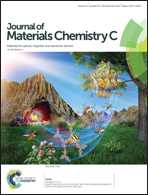Rationally designed particle-in-aperture hybrid arrays as large-scale, highly reproducible SERS substrates†
Abstract
A large-scale, uniform array of particle-in-aperture (PIA) hybrid architectures for highly reproducible surface-enhanced Raman spectroscopy (SERS) is rationally designed and prepared via electrostatic self-assembly of Au nanospheres and vertical deposition of Ag. By controlling the thickness of the Ag coating, polarization-independent ring-shaped hot spots with tunable width can be created around individual nanospheres, offering far higher Raman enhancements than a bare Au nanosphere array and a flat Ag film do. Three PIA substrates with different Ag thicknesses and an identical nanosphere diameter of 58 nm were investigated. Consequently, it is found that a 28 nm Ag coating enables the wavelength matching between the plasmonic coupling band and the laser line, leading to an enhancement factor of up to 4.5 × 106. Meanwhile, remarkable reproducibility of SERS signals is realized by ruling out the impact of anomalous hot spots. To this end, three guidelines are meticulously followed, i.e. using monodisperse Au nanospheres, distributing nanoring cavities evenly onto the substrate, and decoupling adjacent nanoparticles by isolating them far away from each other. This work offers a reliable strategy to fabricate high-performance SERS substrates in a simple, cost-effective and scalable manner, paving the way for practical sensing applications, such as quantitative SERS measurements.



 Please wait while we load your content...
Please wait while we load your content...